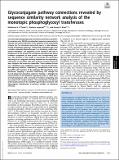Glycoconjugate pathway connections revealed by sequence similarity network analysis of the monotopic phosphoglycosyl transferases
Author(s)
O’Toole, Katherine H; Imperiali, Barbara; Allen, Karen N
DownloadPublished version (2.221Mb)
Publisher Policy
Publisher Policy
Article is made available in accordance with the publisher's policy and may be subject to US copyright law. Please refer to the publisher's site for terms of use.
Terms of use
Metadata
Show full item recordAbstract
The monotopic phosphoglycosyl transferase (monoPGT) superfamily comprises over 38,000 nonredundant sequences represented in bacterial and archaeal domains of life. Members of the superfamily catalyze the first membrane-committed step in en bloc oligosaccharide biosynthetic pathways, transferring a phosphosugar from a soluble nucleoside diphosphosugar to a membrane-resident polyprenol phosphate. The singularity of the monoPGT fold and its employment in the pivotal first membrane-committed step allows confident assignment of both protein and corresponding pathway. The diversity of the family is revealed by the generation and analysis of a sequence similarity network for the superfamily, with fusion of monoPGTs with other pathway members being the most frequent and extensive elaboration. Three common fusions were identified: sugar-modifying enzymes, glycosyl transferases, and regulatory domains. Additionally, unexpected fusions of the monoPGT with members of the polytopic PGT superfamily were discovered, implying a possible evolutionary link through the shared polyprenol phosphate substrate. Notably, a phylogenetic reconstruction of the monoPGT superfamily shows a radial burst of functionalization, with a minority of members comprising only the minimal PGT catalytic domain. The commonality and identity of the fusion partners in the monoPGT superfamily is consistent with advantageous colocalization of pathway members at membrane interfaces.
Date issued
2021Department
Massachusetts Institute of Technology. Department of Biology; Massachusetts Institute of Technology. Department of ChemistryJournal
Proceedings of the National Academy of Sciences of the United States of America
Publisher
Proceedings of the National Academy of Sciences